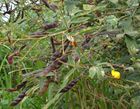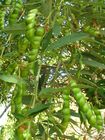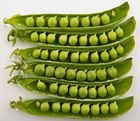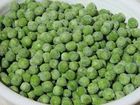Note: This is a project under development. The articles on this wiki are just being initiated and broadly incomplete. You can Help creating new pages.
Cajanus cajan - Adhaki, Pegion pea
The Cajanus cajan is a perennial legume from the Fabaceae family. Since its domestication in India at least 3,500 years ago, its seeds have become a common food in Asia, Africa, and Latin America.
Contents
Uses
Jaundice, Stomachache, Diabetes, Purifying blood, Piles, Tongue sores, Gum inflammation, Spongy gums, Bedsores, Wounds, Malaria.
Parts Used
Chemical Composition
Chemical constituent investigations have indicated that Cajanus cajan leaves are rich in flavonoids and stilbenes. They also contain saponins, conspicuous amount of tannins, and moderate quantities of reducing sugars, resins and terpenoid. Amino acid analysis of the seed extract showed that phenylalanine (26.3% of the total amino acids) is responsible for about 70% of the antisickling potency of the seed extract. Seeds also contain riboflavin and pyridoxine. Root bark contains isoflavones, sterols, triterpenoids, flavones, anthraquinone derivatives. Plant also contains an isoflavone, cajanol.[1]
Common names
| Language | Common name |
|---|---|
| Kannada | Togari, Kari Uddu, Togaribele |
| Hindi | Arahad, Arahar |
| Malayalam | Thuvara, Tuvara |
| Tamil | Tovarai, Thovary |
| Telugu | Kandulu, Kadulu |
| Marathi | NA |
| Gujarathi | NA |
| Punjabi | NA |
| Kashmiri | NA |
| Sanskrit | Tuvari, Adhaki |
| English | Pigeon Pea, Red Gram |
Habit
Identification
Leaf
| Kind | Shape | Feature |
|---|---|---|
| Simple | tri-foliolate,lanceolate | Leafs are 2.5-13.5 cm long to 1-5.5 cm wide. The leaflets are green above and a silvery grey-green beneath and are covered on their lower surfaces in small yellow glands |
.[2]
Flower
| Type | Size | Color and composition | Stamen | More information |
|---|---|---|---|---|
| Unisexual | 14cm long | yellow, papilionaceous | Typical of species belonging to the Leguminosae subfamily Papilionoideae, and resemble, for example, the pea ( Pisum sativum ) flower. Each flower has 10 stamens, 9 of which are fused into a partial tube, with the tenth stamen free. The ovary is positioned above the sepals, petals and stamens. The style is curved | {{{5}}} |
.
Fruit
| Type | Size | Mass | Appearance | Seeds | More information |
|---|---|---|---|---|---|
| straight or sickle | 2-13 cm long x 0.5-1.5 cm | The seeds are 4-9 mm x 3-8 mm and can be white, brown, purplish, black or mottled.
|
many seeds | {{{5}}} | {{{6}}} |
Other features
List of Ayurvedic medicine in which the herb is used
- Vishatinduka Taila as root juice extract
Where to get the saplings
Mode of Propagation
How to plant/cultivate
Seed germinate in about 2 weeks. Quite frequently (in India) pigeon pea is grown mixed with other crops or grown in alternate rows with rows of sorghum, groundnuts, sesame, cotton, pineapples, millets or maize.For pure crops pigeon pea should be sown 2.5–5 cm deep in rows 40–120 cm by 30–60 cm.About 3–4 seeds may be planted in each hill, and later thinned to 2 plants per hill. About 3–4 seeds may be planted in each hill, and later thinned to 2 plants per hill. Plants show little response to fertilizers.[3]
Commonly seen growing in areas
Semi-arid tropics, Humid areas, Cold-free zones.
Photo Gallery
References
External Links
- Ayurvedic Herbs known to be helpful to treat Jaundice
- Ayurvedic Herbs known to be helpful to treat Stomachache
- Ayurvedic Herbs known to be helpful to treat Diabetes
- Ayurvedic Herbs known to be helpful to treat Purifying blood
- Ayurvedic Herbs known to be helpful to treat Piles
- Ayurvedic Herbs known to be helpful to treat Tongue sores
- Ayurvedic Herbs known to be helpful to treat Gum inflammation
- Ayurvedic Herbs known to be helpful to treat Spongy gums
- Ayurvedic Herbs known to be helpful to treat Bedsores
- Ayurvedic Herbs known to be helpful to treat Wounds
- Ayurvedic Herbs known to be helpful to treat Malaria
- Herbs with Seeds used in medicine
- Herbs with Leaves used in medicine
- Herbs with common name in Kannada
- Herbs with common name in Hindi
- Herbs with common name in Malayalam
- Herbs with common name in Tamil
- Herbs with common name in Telugu
- Herbs with common name in Sanskrit
- Herbs with common name in English
- Habit - A small erect shrub
- Index of Plants which can be propagated by Seeds
- Index of Plants which can be propagated by Cuttung
- Herbs that are commonly seen in the region of Semi-arid tropics
- Herbs that are commonly seen in the region of Humid areas
- Herbs that are commonly seen in the region of Cold-free zones
- Herbs
- Fabaceae





